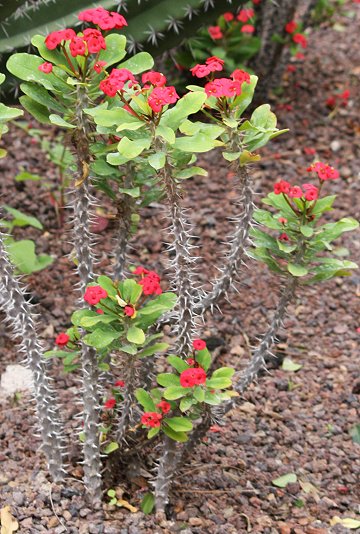
|
|
Crown of Thorns
(Euphorbia milii).
|
Crown of Thorns - Euphorbia milii
Euphorbia milii, the crown of thorns, Christ plant, or Christ thorn, called Corona de Cristo in Latin America (coroa-de-cristo in Brazil), is a species of flowering plant in the spurge family Euphorbiaciae, native to Madagascar. The species name commemorates Baron Milius, once Governor of Reunion, who introduced the species to France in 1821. It is imagined that the species was introduced to the Middle East in ancient times, and legend associates it with the crown of thorns worn by Christ.
Euphorbia milii, is a woody, succulent shrub that features (a) fleshy, bright green leaves, (b) inconspicuous flowers in clusters subtended by very showy petal-like red or yellow bracts and (c) thick sharp black thorns (to
1,5 cm long) which cover its water-storing branches and stems and help it scramble over other plants.
In Madagascar, this shrub typically grows in a sprawling form to
1,50 -1,80 m. tall. As a houseplant, it grows at best to 60 cm tall. Obovate bright green leaves (to
60 cm long) have wedge-shaped bases.
Leaves are produced on new stem growth. Inconspicuous greenish true flowers, borne in cyathia, lack both petals and sepals, but are subtended by long-lasting, colorful, petal-like, bright red or yellow bracts which are exceptionally showy. In tropical and sub-tropical locations, flowers will bloom throughout the year, but primarily in spring and summer.
Houseplants often bloom from late winter well into fall. Many cultivars are available in commerce.
Genus name probably honors Euphorbus, physician to the King of Mauretania.
Specific epithet honors Baron Milius, one-time Governor of the island of Bourbon, who reportedly introduced this species to cultivation in France in 1821.
Common name refers to the belief by some that the crown of thorns worn by Jesus Christ at the crucifixion was made from stems of this plant (historical evidence suggests this Madagascar native may have been introduced to the Middle East prior to the birth of Christ).
The sap is moderately poisonous, and causes irritation on contact with skin or eyes. If ingested, it causes severe stomach pain, irritation of the throat and mouth, and vomiting. The poisonous ingredients have been identified as phorbol esters.
Wat Phrik in Thailand claims to be the home of the world's tallest Christ thorn plant.
There are a number of varieties (at least eleven) of which var. splendens is the most popularly cultivated.
Euphorbia milii var. splendens is a variety of the species Euphorbia milii. Like the other varieties of E.milii (and, indeed, like many other plants in the spurge family Euphorbiaceae) E.m.var.splendens produces a milky latex that is an irritant poison. Under the name sijou (alternative spelling sijwu) the plant (known formerly to science as Euphorbia splendens) is considered to be sacred in the Bathouist religion of the Bodo people of Assam, West Bengal, Nagaland and Nepal - in which it symbolises the supreme deity, Bathoubwrai (Master of the Five Elements). This cultivation for ritual purposes of the sijou tree was particularly strong among the Bodo people (known also as Mech) of the Goalpara region.
Families that follow Bathouism plant a sijou shrub at the northeast corner of their courtyard in an altar referred to as the sijousali. Bodo communities that follow Bathouism generally plant a sijou shrub/small tree in a piece of communally-owned land.
Source:
https://en.wikipedia.org/wiki/Euphorbia_milii
http://www.missouribotanicalgarden.org/PlantFinder/
PlantFinderDetails.aspx?kempercode=b633
https://www.wordreference.com/engr/subtend
https://en.wikipedia.org/wiki/Euphorbia_milii_var._splendens
